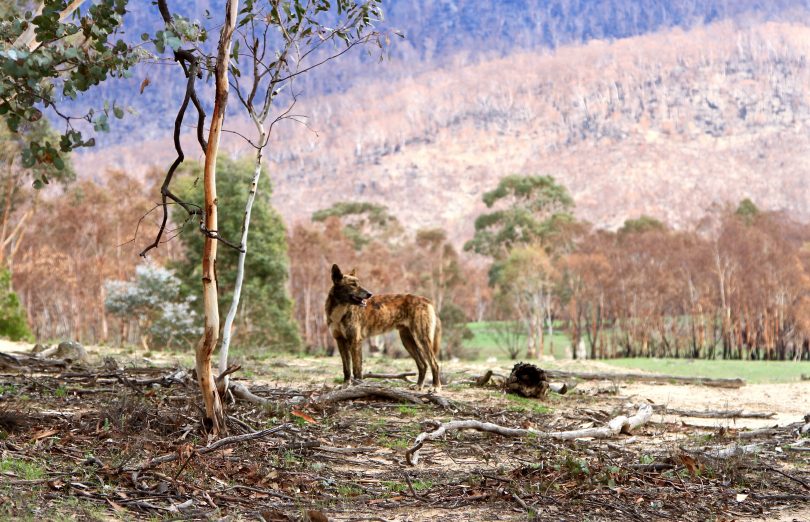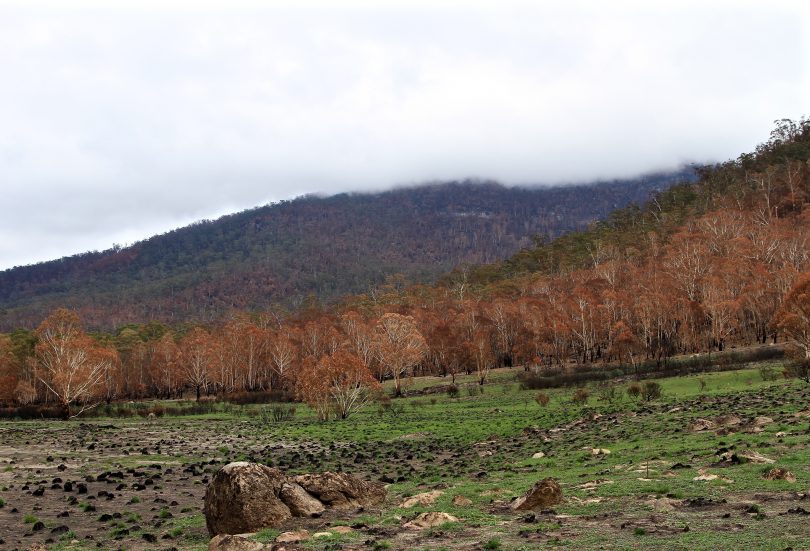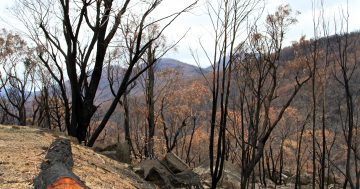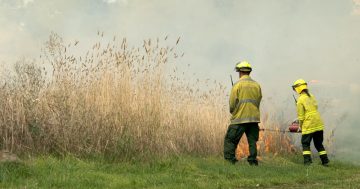
A wild dog eyes a burnt landscape in the Namadgi National Park. Photos: Michael Weaver.
The ACT was able to perform a rapid risk assessment of endangered animals and threatened fauna in the Namadgi National Park within five days of the Orroral Valley fire, a process which took months in 2003, Territory officials told the Royal Commission into National Natural Disaster Arrangements.
Giving evidence to the commission – colloquially known as the Bushfire Royal Commission – senior ecologist with the ACT Environment, Planning and Sustainable Development Directorate (EPSDD), Julian Seddon, said they were able to assess the impact of the fires on the endangered alpine sphagnum bogs and fens faster than previously possible.
“The advantage of the rapid risk assessment team is that it is supported by the [incident management team] to get in there and make those assessments as soon as possible,” he said.
“That creates an advantage in terms of avoiding further damage – particularly in the early post-fire recovery period where it is another source of environmental damage.
“Sometimes the effects of post-fire erosion are more damaging that the bushfire itself.”
Australia-wide, 300 species – or just under 17 per cent – listed as threatened under the Environmental Protection and Biodiversity Conservation Act (EPBC) were caught in the path of the fire and had more than 10 per cent of their range affected.
The Commonwealth Threatened Species Commissioner, Dr Sally Box, told the royal commission that the black summer bushfires were an “ecological disaster”, naming 119 animals – 18 in the ACT – in need of urgent intervention after the fires.
Dr Sally Box said so many species were impacted because of the fires unusually large spread and intensity.
“The entire range of some species was burnt,” Dr Box said.
“Forty-nine threatened species had more than 80 per cent of their known or likely range within the fire extent.
“A further 65 threatened species had more than 50 per cent of their known or likely range in the fire extent and this includes plants and mammals and plants and reptiles and fish and invertebrates.”

The bog in the Gudgenby Valley below Mt Namadgi.
The Orroral Valley fire burnt more than 80 per cent of the Namadgi National Park but spared the endangered bogs and fens, home to species like the critically endangered northern corroboree frog.
The executive group manager of the environment at EPSDD, Ian Walker, said the ACT had already established an incident management team in mid-January – before the Orroral Valley even started – to monitor the potential impact of fires from NSW on the national park. The bogs and fens in the national park are responsible for 80 per cent of the ACT’s water supply, he said.
“We were concerned of the risk of those fires [Dunns Road and Mary’s Hill fires] travelling east into the ACT and impacting the Namadgi National Park, and in particular, our Cotter Catchment area.”
The dry conditions across the ACT and NSW, exacerbated by years of drought, led the EPSDD to predict a significant fire season back in September.
“When it started to become very real was our first deployment of Parks and Conservation staff and others to Queensland and that occurred in September, which was quite early,” Mr Walker told the commission.
However, despite the Orroral Valley fire burning within six kilometres of Tharwa, heavy rains in mid-February meant that the fire never reached the lines of fire retardant which were dropped around the bogs high up in the mountains.
While fire is one of the biggest threats to the endangered bogs, “climate change and its associated impacts pose the greatest threat to the bogs and fens in the long-term”, the Directorate’s website says.
Mr Seddon told the royal commission that the isolated and small extent of bogs has made them susceptible to being lost over time because of the severe and existential threat posed by fire and a warming climate.















